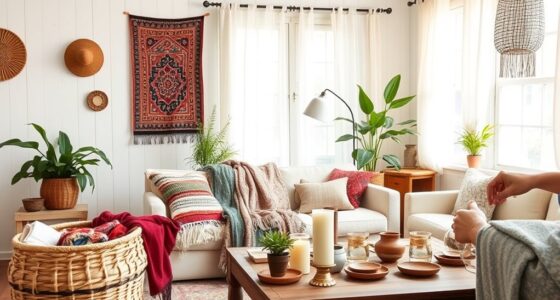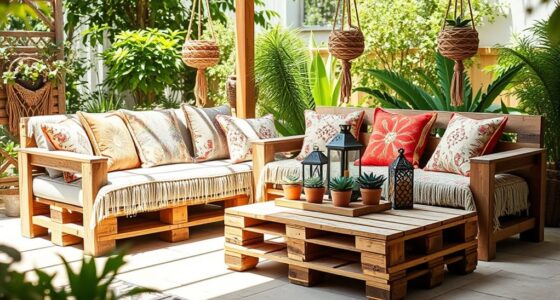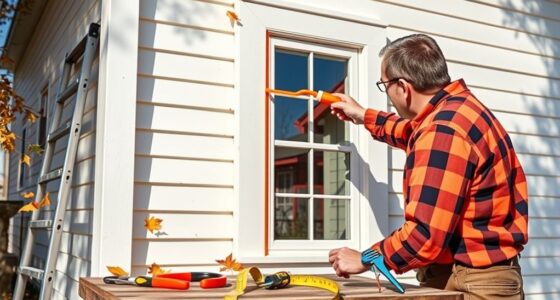To make your home more sustainable, consider using reclaimed wood for added character and durability while reducing waste and conserving forests. Pair it with eco-friendly, low VOC paints made from natural pigments to improve indoor air quality and create vibrant, safe spaces. Incorporate these materials in various areas of your home, from feature walls to furniture, and choose finishes that are both eco-conscious and long-lasting. Exploring these options further can help you create a healthier, eco-friendly living environment.
Key Takeaways
- Incorporate reclaimed wood for durability, character, and rustic charm, reducing waste and conserving forests.
- Use low VOC or natural pigments paints to improve indoor air quality and support eco-friendly living.
- Apply reclaimed wood in various home areas like feature walls, kitchen islands, and headboards for sustainable style.
- Select certified, VOC-free paints and natural finishes to ensure safe, environmentally responsible decorating choices.
- Conduct energy audits and upgrade insulation, lighting, and materials to maximize overall eco-conscious home performance.
Benefits of Using Reclaimed Wood in Your Home
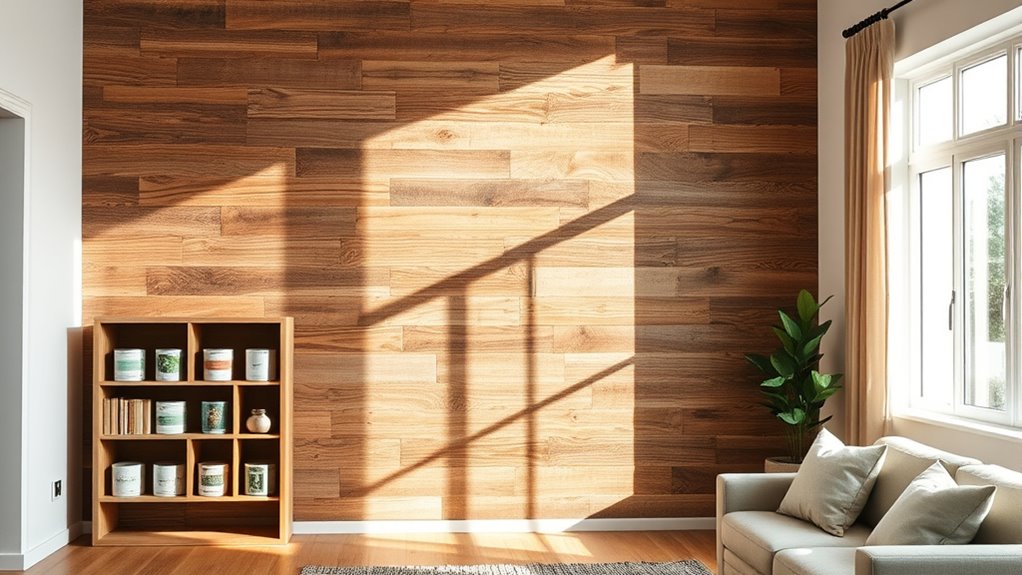
Have you ever considered how using reclaimed wood can enhance your home? Reclaimed wood brings a unique character through its rich wood grain, showcasing natural imperfections and history. This material adds rustic charm, creating a warm, inviting atmosphere that’s hard to replicate with new lumber. Besides aesthetic appeal, reclaimed wood is eco-friendly, reducing demand for virgin timber and helping conserve forests. Its durability means your projects will stand the test of time, often more resilient than new wood. Additionally, each piece tells a story, adding personality and authenticity to your space. Using reclaimed wood not only boosts your home’s charm but also supports sustainable practices, making your renovation both stylish and environmentally responsible. Moreover, understanding the sustainability benefits of reclaimed materials can further inform your eco-conscious choices. Incorporating reclaimed wood can also contribute to reducing waste by repurposing materials that might otherwise be discarded. Recognizing the role of resilience in material selection can help ensure your home improvement investments are long-lasting. Exploring innovative reclaimed products can open up even more creative possibilities for eco-friendly home upgrades and promote biodiversity by reducing deforestation pressures.
Choosing Eco-Friendly Paints for a Healthier Living Space
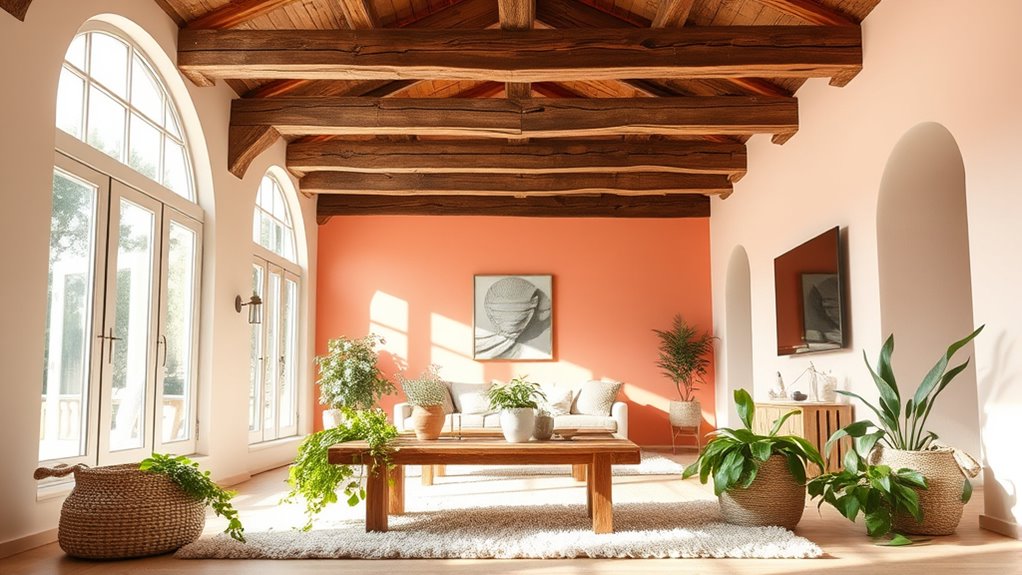
To create a healthier living space, choosing eco-friendly paints is a crucial step. Opt for low VOC paints, which emit fewer harmful chemicals, improving indoor air quality. Natural pigments are another great choice; they offer vibrant colors without synthetic additives. These paints reduce your exposure to toxic fumes and support better health. When selecting eco-friendly paints, check labels for certifications like Green Seal or EcoLabel to ensure quality. Here’s a quick comparison:
| Feature | Conventional Paints | Eco-Friendly Paints | Benefits |
|---|---|---|---|
| VOC Levels | High | Low | Less odor, fewer toxins |
| Pigment Type | Synthetic | Natural | Safer, eco-conscious |
| Indoor Air Quality | Potentially harmful | Safer for families | Promotes healthier environment |
| Durability | Varies | Comparable | Long-lasting, eco-friendly |
Additionally, eco-friendly paints often incorporate reclaimed materials in their formulations, further enhancing their sustainability profile. Incorporating sustainable ingredients helps minimize environmental impact and supports eco-friendly home improvements. Using paints with high-quality pigments can also improve color longevity and appearance over time.
Incorporating Reclaimed Wood Into Different Areas of Your Home

Incorporating reclaimed wood into your home adds character and sustainability to your space. You can create vintage accents with reclaimed wood in your living room by making a feature wall or crafting unique shelves that showcase its rustic charm. In the kitchen, consider repurposing old wood for a farmhouse-style island or a backsplash that highlights eco-friendly choices. Bedrooms can benefit from reclaimed wood headboards or bedside tables, adding warmth and texture. Even in bathrooms, reclaimed wood accents like framed mirrors or storage solutions bring a cozy, rustic feel. By thoughtfully integrating reclaimed wood across different areas, you not only reduce waste but also introduce timeless, eco-conscious style that enhances your home’s character. Additionally, choosing sustainable materials such as reclaimed wood ensures your home improvement projects contribute to environmental conservation. Incorporating natural elements like reclaimed wood can also promote a calming and inviting atmosphere in your living spaces. To maximize the benefits of eco-friendly choices, understanding preservation efforts in historic sites can inspire your sustainable renovations and foster a deeper connection to regional heritage. Integrating recycling practices into your renovation process can further reduce your environmental impact and support a circular economy. Incorporating dynamic communication exercises into your design process can foster better collaboration with contractors and designers, ensuring your vision aligns with eco-friendly practices.
Tips for Selecting Sustainable Paints and Finishes
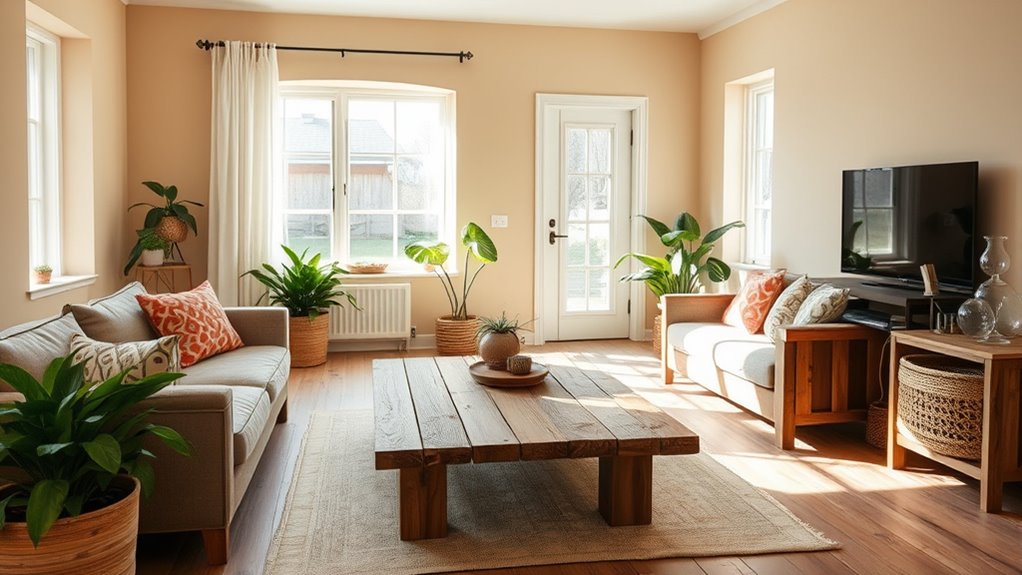
As you embrace sustainable upgrades throughout your home, choosing eco-friendly paints and finishes plays a vital role in reducing environmental impact. Start by looking for options with natural pigments, which use plant-based or mineral-based colors that are less toxic. These pigments often provide vibrant, durable hues without harmful chemicals. Prioritize VOC free options, as volatile organic compounds release fumes that can harm indoor air quality and contribute to pollution. Read labels carefully to ensure the paints are certified eco-friendly, and avoid those with synthetic solvents or synthetic dyes. Additionally, opt for finishes like natural oils or plant-based sealants that offer protection without compromising sustainability. Making informed choices helps you create a healthier, more eco-conscious living space while minimizing your home’s ecological footprint.
Practical Steps to Start Your Eco-Conscious Renovation

Starting your eco-conscious renovation begins with setting clear goals and evaluating your current home environment. Identify areas where you can improve energy efficiency and plan DIY decor projects that incorporate sustainable materials. To get started, consider these practical steps:
- Conduct an energy audit to spot inefficiencies
- Replace old bulbs with LED or eco-friendly lighting
- Plan DIY decor projects using reclaimed wood or recycled materials
- Prioritize upgrades like better insulation or weatherproofing
- Set a budget for eco-friendly upgrades and materials
- Incorporate sustainable design principles to ensure your renovation minimizes environmental impact and aligns with the broader goals of ethical hacking, such as identifying vulnerabilities and ensuring system security in your home technology.
Frequently Asked Questions
How Does Reclaimed Wood Impact Indoor Air Quality?
Reclaimed wood generally improves indoor air quality by reducing VOC emissions compared to new wood, which can release harmful chemicals. It also helps minimize indoor allergens since it’s often been cleaned and processed, lowering dust and mold risks. By choosing reclaimed wood, you create a healthier indoor environment, decreasing potential respiratory issues and ensuring less exposure to airborne toxins, making your home safer and more eco-friendly.
Are Eco-Friendly Paints More Cost-Effective Long-Term?
Think of eco-friendly paints as a wise investment, like planting a tree that bears fruit over time. They often cost more upfront, but you save money through better paint durability and reduced health risks. Over the long run, you’ll enjoy cost savings on frequent repainting and health-related expenses. So, eco-friendly paints can be more cost-effective in the long term, making your home healthier and your wallet happier.
Can Reclaimed Wood Be Used in Outdoor Furniture?
Yes, you can use reclaimed wood for outdoor furniture, but consider outdoor durability. Reclaimed wood often boasts reclaimed aesthetics, giving your furniture a unique, rustic charm. To guarantee longevity, treat the wood with sealants and finishes designed for outdoor use. This way, you’ll enjoy the reclaimed aesthetics while enhancing outdoor durability, making your furniture both beautiful and resilient against the elements.
What Certifications Should I Look for in Sustainable Paints?
Did you know that VOC emissions from paints can account for up to 10% of indoor air pollution? When choosing sustainable paints, look for certifications like Green certifications and verify they meet VOC standards. These certifications guarantee low emissions, protecting your health and the environment. By selecting paints with these marks, you’re making a responsible choice that supports healthier indoor air quality and sustainability efforts.
How Do Reclaimed Materials Affect Home Insurance Policies?
Reclaimed wood can influence your home insurance policies, mainly due to its durability and condition. If the reclaimed wood is sturdy and well-maintained, it might not considerably affect your insurance premium. However, if it’s aged or damaged, insurers could see it as a higher risk, potentially increasing premiums. Always check with your insurer to understand how reclaimed materials, especially reclaimed wood, impact coverage and premiums before starting your project.
Conclusion
By choosing reclaimed wood and eco-friendly paints, you’re not just improving your home—you’re helping the planet. Some believe that small actions can’t make a difference, but history shows otherwise; collective efforts can lead to meaningful change. Every eco-friendly upgrade you make proves that sustainable living starts with you. So, embrace these choices and transform your space into a healthier, greener sanctuary—because your home and the Earth deserve it.



